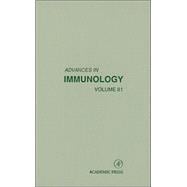
Note: Supplemental materials are not guaranteed with Rental or Used book purchases.
Purchase Benefits
What is included with this book?
| CONTRIBUTORS | ix | ||||
| FOREWORD | xiii | ||||
| Regulation of the Immune Response by the Interaction of Chemokines and Proteases | |||||
|
|||||
|
|||||
|
13 | (7) | |||
|
20 | (3) | |||
|
23 | (9) | |||
|
32 | (13) | |||
| Molecular Mechanisms of Host-Pathogen Interaction: Entry and Survival of Mycobacteria in Macrophages | |||||
|
|||||
|
45 | (6) | |||
|
51 | (6) | |||
|
57 | (8) | |||
|
65 | (5) | |||
|
70 | (14) | |||
|
84 | (1) | |||
|
85 | (12) | |||
| B Lymphoid Neoplasms of Mice: Characteristics of Naturally Occurring and Engineered Diseases and Relationships to Human Disorders | |||||
|
|||||
|
97 | (5) | |||
|
102 | (7) | |||
|
109 | (7) | |||
|
116 | (1) | |||
|
116 | (7) | |||
| Prions and the Immune System: A Journey Through Gut, Spleen, and Nerves | |||||
|
|||||
|
123 | (5) | |||
|
128 | (6) | |||
|
134 | (3) | |||
|
137 | (4) | |||
|
141 | (2) | |||
|
143 | (5) | |||
|
148 | (2) | |||
|
150 | (3) | |||
|
153 | (5) | |||
|
158 | (1) | |||
|
159 | (1) | |||
|
160 | (13) | |||
| Roles of the Semaphorin Family in Immune Regulation | |||||
|
|||||
|
173 | (4) | |||
|
177 | (10) | |||
|
187 | (4) | |||
|
191 | (1) | |||
|
192 | (1) | |||
|
193 | (1) | |||
|
194 | (1) | |||
|
195 | (4) | |||
| HLA-G Molecules: from Maternal-Fetal Tolerance to Tissue Acceptance | |||||
|
|||||
|
199 | (2) | |||
|
201 | (5) | |||
|
206 | (7) | |||
|
213 | (4) | |||
|
217 | (8) | |||
|
225 | (7) | |||
|
232 | (4) | |||
|
236 | (7) | |||
|
243 | (10) | |||
| The Zebrafisk as a Model Organism to Study Development of the Immune System | |||||
|
|||||
|
253 | (4) | |||
|
257 | (15) | |||
|
272 | (18) | |||
|
290 | (6) | |||
|
296 | (10) | |||
|
306 | (1) | |||
|
307 | (4) | |||
|
311 | (2) | |||
|
313 | (2) | |||
|
315 | (1) | |||
|
316 | (15) | |||
| Control of Autoimmunity by Naturally Arising Regulatory CD4+ T Cells | |||||
|
|||||
|
331 | (2) | |||
|
333 | (5) | |||
|
338 | (4) | |||
|
342 | (3) | |||
|
345 | (7) | |||
|
352 | (12) | |||
|
364 | (1) | |||
|
365 | (8) | |||
| INDEX | 373 | (12) | |||
| CONTENTS OF RECENT VOLUMES | 385 |
The New copy of this book will include any supplemental materials advertised. Please check the title of the book to determine if it should include any access cards, study guides, lab manuals, CDs, etc.
The Used, Rental and eBook copies of this book are not guaranteed to include any supplemental materials. Typically, only the book itself is included. This is true even if the title states it includes any access cards, study guides, lab manuals, CDs, etc.